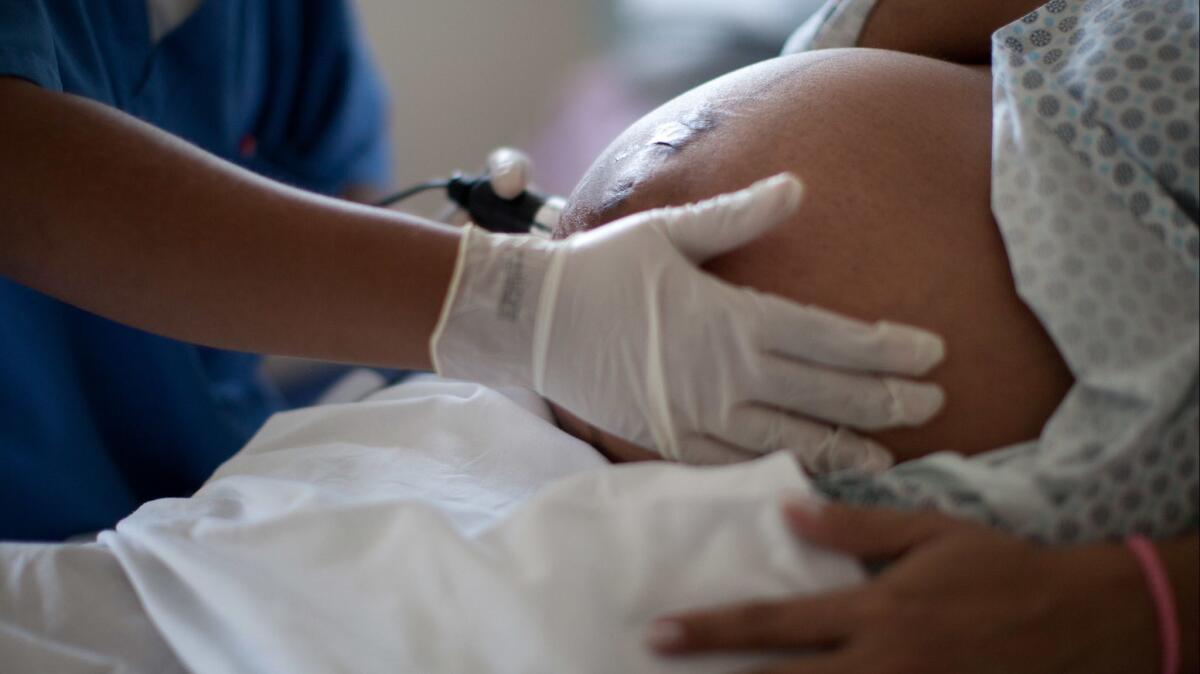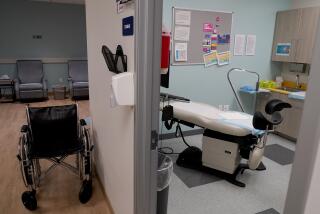Op-Ed: American women are having too many caesareans, at too much risk

In 1976, a young, first-time mother entered the hospital in spontaneous labor. She had not missed any prenatal visits, those visits had revealed no abnormalities, her pregnancy was full-term, and she carried one fetus positioned headfirst. In other words, hers was a prototypical low-risk pregnancy. She felt great. Then a physician ruptured her amniotic sac, hastening labor.
“I went,” she told me years later, “from feeling nothing to being totally in excruciating pain.”
A nurse attached her to what was then a relatively new device — an electronic fetal monitor. Physicians reviewed the monitor strip and told the mother she had to make a decision, and fast. “They said either that I would die, or my baby would die, or both of us would die, if I didn’t have a caesarean. They said her heart was in distress.”
At about 10.5% of births, caesareans were far less common in the United States in 1976 than they are today, when almost one in three births is by caesarean section. The steepest increase in the surgery occurred between 1965 and 1987, when caesareans rose 455% — from 4.5% to 25% of births. Doctors have long debated which factors contributed to that precipitous rise. Was it the malpractice climate? Changes in the training of obstetricians? An epidemic of maternal obesity? Women delaying childbearing? Or perhaps the culture of scheduled, “hurry-up” births? Almost always missing from the list is the effect of the electronic fetal monitor on obstetricians’ decision-making. As the mother learned in 1976, the monitor increased the likelihood that a physician would tell a laboring woman that she needed a caesarean section.
Under the perpetual gaze of the machine, fetal distress, once an infrequent diagnosis, had become commonplace.
Although used routinely by American hospitals today, the electronic fetal monitor has a fraught history. The device first appeared in select hospitals in 1969. The value of the technology seemed so obvious that no one tested it for efficacy before its release. Most obstetricians were certain that continually monitoring the fetal heartbeat during labor would help ensure good outcomes by immediately alerting doctors to fetal distress. A timely caesarean could follow. Physicians predicted that the monitor would reduce by half fetal deaths during labor, “mental retardation” and cerebral palsy.
In fact, perinatal mortality did decrease. However, public health officials pointed out that hospitals not employing monitors were seeing the same effect thanks to a revolution in pediatrics that paralleled the use of the fetal monitor. New subspecialties of neonatology and perinatology had improved prenatal care, maternal nutrition and newborn care.
Most obstetricians nevertheless continued to believe that the electronic fetal monitor deserved the lion’s share of credit for the improvement in infant health. By 1976, American doctors were so bullish on the monitor that they employed it in half of all hospital births. An even greater tip-off that the monitor would become a linchpin of maternity care was a 1976 survey indicating that all but one of the country’s obstetric residency programs employed the technology.
In 1976, researchers also performed the first randomized, controlled trial of the device. Before the advent of the monitor, physicians checked the fetal heart rate with a special stethoscope every 30 minutes or so during labor. The 1976 trial assigned the use of the monitor to one group of laboring women and the “fetoscope” to the other group.
According to the study, the monitor didn’t change outcomes. Apgar scores, rates of neurological disability, admissions to neonatal intensive care units, stillbirths, and neonatal and perinatal deaths were effectively identical in both groups. The sole difference was that 16.5% of the electronically monitored women gave birth by caesarean, and only 6.8% of the intermittently fetoscoped mothers did. Subsequent studies saw similar results.
Under the perpetual gaze of the machine, fetal distress, once an infrequent diagnosis, had become commonplace. Edward Hon, the Yale University obstetrician who invented the monitor, complained that colleagues across the country were “dropping the knife with each drop in the fetal heart rate.” Before electronic monitoring, no one had continually observed the fetal heartbeat throughout labor, and its accelerations and decelerations in response to contractions were perplexing. Misinterpretations were common. Hospitals were seeing false positive rates for fetal hypoxia (lack of oxygen) of 40%. And doctors responded by erring on the side of caution, performing emergency caesareans.
Physicians, mothers and health insurers have good reason to be concerned about this phenomenon. A caesarean section is major abdominal surgery and comes with its attendant risks: infection, hemorrhage and potentially fatal placental anomalies in subsequent pregnancies caused by a scarred uterus. Surgical birth comes with risks for newborns too. The lungs of all fetuses are filled with amniotic fluid in utero, the trip through the birth canal squeezes out that fluid. Babies delivered by caesarean section, on the other hand, are born with wet lungs, making them more likely than their vaginally born counterparts to spend time in the neonatal intensive care unit and to suffer from asthma.
Enter the Fray: First takes on the news of the minute from L.A. Times Opinion »
Although a caesarean section can be necessary and even life-saving, the World Health Organization advises that the optimal caesarean rate is between 10% and 15% of births. A rate higher than 10% is not associated with improved maternal or neonatal outcomes, and a rate over 15% does more harm than good. In other words, most caesareans performed in the United States today are unnecessary and therefore unjustifiably risky.
Obstetricians trained since the 1980s have no memory of maternity floors before the fetal monitor. Although their professional organization, the American College of Obstetricians and Gynecologists, has issued periodic bulletins since 1979 advising that the fetal monitor does not appear to be useful in low-risk pregnancies, that interpreting monitor strips correctly “is not an easy matter,” and that universal reliance on the monitor has led to an unnecessary increase in caesareans, the monitor remains in near-universal use in American hospitals, even for low-risk births. Covered California has set a caesarean-rate target of 23.9% of low-risk births for the hospitals in its networks. One way to achieve that target is to bring back the fetal stethoscope and limit electronic fetal monitoring to high-risk pregnancies.
Jacqueline H. Wolf, professor of the history of medicine at Ohio University, is the author of “Cesarean Section: An American History of Risk, Technology, and Consequence.”
Follow the Opinion section on Twitter @latimesopinionand Facebook
More to Read
A cure for the common opinion
Get thought-provoking perspectives with our weekly newsletter.
You may occasionally receive promotional content from the Los Angeles Times.






